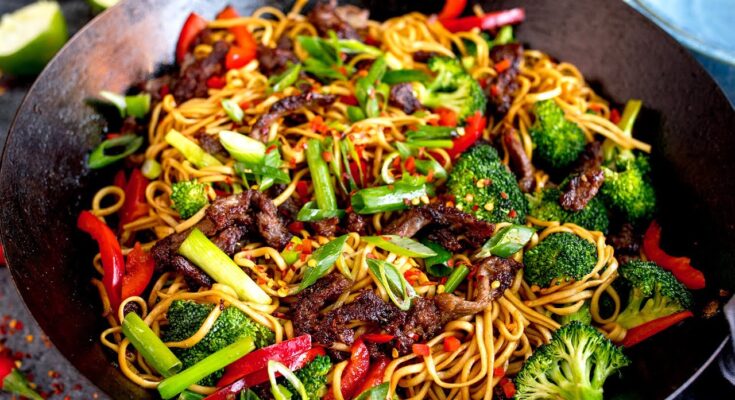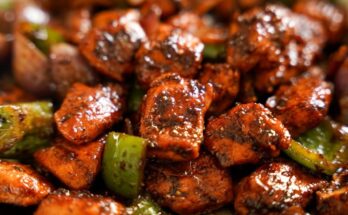Beef Noodles Recipe: Beef noodles are the kind of dish that hits all the right notes—savory, hearty, and incredibly satisfying. Whether you’re craving a comforting bowl on a cold day or just in the mood for something meaty and slurp-worthy, this recipe has got you covered.
Today, we’re going full-on flavor mode, and I’ll guide you through every single step to help you create a bowl of beef noodles that’s better than takeout. Trust me, once you master this dish, it’ll become a go-to in your weekly dinner rotation.
Why Beef Noodles Are a Comfort Food Favorite
Let’s be honest—there’s something magical about the combination of tender beef and chewy noodles swimming in a rich, savory broth. It’s a warm hug in a bowl. Beef noodles have universal appeal across cultures for a reason: they bring together carbs, protein, and umami in a way that feels both indulgent and nourishing. The flavors can range from subtle and clear to bold and spicy, depending on the style. And let’s not forget how customizable they are. Add veggies, switch up the seasoning, make it spicy or mild—the world is your noodle bowl!
Types of Beef Noodles Around the World
Beef noodles aren’t just one dish—they’re a category. Every culture has its own twist, and each one brings something special to the table.
Chinese Beef Noodles
This version often includes hand-pulled wheat noodles, tender braised beef shank, and a deeply flavored soy-based broth with hints of ginger and star anise.
Taiwanese Braised Beef Noodles
A cult favorite, this bowl features slow-cooked beef in a spicy, soy-based broth that’s rich and aromatic. Often garnished with pickled mustard greens.
Vietnamese Pho Bo
Pho Bo is a light, clear beef broth loaded with rice noodles, thinly sliced beef, and fresh herbs like basil and cilantro. The flavors are complex but delicate.
Western-Style Beef Noodle Soup
This is a more straightforward approach—think beef stew with noodles. It’s hearty, simple, and very kid-friendly.
Key Ingredients You’ll Need
Let’s break down what goes into a truly great bowl of beef noodles. Below are the essentials, followed by a few add-ins that can kick the flavor up a notch.
Main Ingredients
- Beef (Chuck, Brisket, or Shank) – For that tender, fall-apart texture.
- Noodles (Wheat or Rice, Depending on the Style)
- Garlic & Ginger – The aromatics that start the flavor party.
- Soy Sauce (Light and Dark)
- Star Anise & Cinnamon Stick
- Beef Broth or Stock – Homemade or store-bought.
- Green Onions
- Cooking Oil (Preferably Neutral like Canola or Peanut Oil)
Optional Add-Ins for Extra Flavor
- Chili Oil or Paste – For a spicy kick.
- Pickled Mustard Greens – A Taiwanese favorite.
- Shaoxing Wine – Adds depth and authenticity.
- Bok Choy or Baby Spinach
- Coriander (Cilantro)
Choosing the Right Cut of Beef
Not all beef is created equal when it comes to beef noodles. You want something that gets tender over time, not dry and tough. Cuts like chuck, brisket, or shank are ideal because they’re full of connective tissue that breaks down beautifully during slow cooking. If you want something quicker, go for sirloin or flank steak, but be sure not to overcook them—they go from tender to tough fast. And if you want restaurant-quality? Use a combo of bones for broth and meat for bite. That’s the secret to richness and depth.
How to Choose the Best Noodles
Noodles can make or break this dish. If you’re going traditional, Chinese wheat noodles are the go-to. They have a chewy bite and hold up well in broth. For a Vietnamese twist, flat rice noodles are ideal. You can also use fresh noodles if you have access to them—just reduce the cooking time. Ramen noodles, udon, or even Italian pasta like fettuccine can work in a pinch, but they’ll change the vibe a bit. Always cook them separately from the broth to prevent starch from clouding it up.
Essential Pantry Items for Flavor
The depth of your beef noodle soup lies in the little things—those pantry staples that quietly bring it all together.
- Light Soy Sauce – Salty and bright.
- Dark Soy Sauce – Adds color and a deeper, caramelized flavor.
- Oyster Sauce – Optional, but a fantastic flavor booster.
- Five-Spice Powder – A quick way to add complexity.
- Sesame Oil – For drizzling at the end.
- Brown Sugar or Rock Sugar – Adds balance and enhances umami.
- Rice Vinegar or Chinese Black Vinegar – Brightens things up.
Kitchen Tools You’ll Need
You don’t need a fancy kitchen, just the right basics:
- Large Pot or Dutch Oven
- Skillet or Wok (for searing)
- Fine Mesh Strainer
- Cutting Board & Sharp Knife
- Soup Ladle
- Tongs or Chopsticks
Step-by-Step Guide to Cooking Beef Noodles
This is where the magic happens. Get your apron on!
Step 1: Prepping the Beef
Start by slicing your beef thinly against the grain—flank, sirloin, or ribeye works best. Trim excess fat and pat dry to help it sear beautifully later.
Step 2: Marinating for Maximum Flavor
In a bowl, combine soy sauce, oyster sauce, garlic, ginger, sesame oil, and a pinch of sugar. Add the beef slices and toss well. Let it marinate for at least 20–30 minutes to soak up all those savory flavors.
Step 3: Searing the Beef
Heat a wok or large skillet over high heat with a drizzle of oil. Add the beef in batches and sear quickly until browned—avoid overcrowding to keep it juicy. Remove and set aside.
Step 4: Creating a Flavorful Broth
In the same pan, sauté garlic and onions, then pour in beef stock, soy sauce, and a touch of chili paste. Simmer for 10 minutes to build depth.
Step 5: Cooking the Noodles
Boil egg noodles or rice noodles until just tender. Drain and toss lightly in sesame oil to prevent sticking.
Step 6: Bringing It All Together
Add the cooked noodles to the simmering broth, return the seared beef, and toss to coat evenly. Garnish with chopped scallions and a sprinkle of sesame seeds. Serve steaming hot—comfort in a bowl!
Topping Ideas to Elevate Your Dish
Want to make your beef noodles restaurant-worthy? It’s all about the toppings. Think of them like the accessories that complete your outfit—they may be small, but they make a big impact.
Here are some of the best topping ideas:
- Soft-Boiled Egg – Adds richness. Cook for 6 minutes, peel, and slice in half.
- Chili Oil or Crispy Chili Garlic Sauce – Adds heat and texture.
- Pickled Mustard Greens – A must for Taiwanese-style beef noodles.
- Fresh Herbs – Cilantro, Thai basil, or mint can brighten the dish.
- Fried Shallots or Garlic Chips – Crunchy and aromatic.
- Scallions – Always a classic.
- Lime Wedges – If you’re doing a pho-style version.
Mix and match to suit your taste. These toppings add layers of flavor and texture that take your beef noodle soup to a whole new level.
Common Mistakes to Avoid
Even the best intentions can lead to noodle soup disaster. Let’s avoid those rookie mistakes, shall we?
1. Overcooking the Noodles
As mentioned earlier, noodles should always be cooked separately and added just before serving. Overcooked noodles are mushy and absorb too much broth.
2. Skipping the Sear
Searing the beef isn’t just for color—it builds flavor. That deep, caramelized crust on the meat is what gives your broth that restaurant-quality taste.
3. Not Skimming the Broth
Foam and fat will rise as the broth simmers. If you don’t skim it off, you’ll end up with a cloudy, greasy broth. Skimming = clarity and clean flavor.
4. Going Overboard with Spices
A little star anise and cinnamon go a long way. Don’t dump a whole spice rack in the pot—balance is key.
5. Using Low-Quality Beef or Broth
If your base ingredients aren’t flavorful, your soup won’t be either. Choose well-marbled beef and, if possible, use homemade or high-quality broth.
Serving Suggestions and Pairings
Beef noodles are a meal in themselves, but if you want to serve a full spread (especially for guests), here are some ideas:
Appetizers:
- Spring rolls
- Dumplings
- Scallion pancake
Side Dishes:
- Light cucumber salad with sesame dressing
- Stir-fried greens like Chinese broccoli or bok choy
Beverages:
- Jasmine tea or iced green tea
- A light beer or sake if you’re going the adult route
Want to go fusion? Serve with a slice of crusty bread or garlic toast to soak up the broth. Hey, it’s your kitchen—have fun with it!
How to Store and Reheat Leftovers
Made too much? No worries—beef noodles make fantastic leftovers.
Storage Tips:
Broth and Noodles Should Be Stored Separately.
- Store the broth with beef and veggies in an airtight container for up to 4 days in the fridge.
- Keep the noodles in a separate container and toss them with a little oil to prevent sticking.
Freezing:
You can freeze the broth and beef (without the noodles) for up to 3 months. Let it cool completely before freezing in portions.
Reheating:
- Reheat broth on the stove over medium heat until simmering.
- Soak noodles in hot water for a few minutes or briefly microwave them.
- Combine and garnish again for a fresh-feeling bowl.
Health Benefits of Homemade Beef Noodles
Sure, this dish is indulgent, but it’s not all about comfort—it’s also nourishing when done right.
- Protein-Rich: Thanks to the beef, you’re getting a hefty dose of protein which helps in muscle recovery and keeps you full longer.
- Customizable for Veggies: Add bok choy, spinach, carrots, mushrooms—you name it. You’ll boost your fiber and vitamin intake.
- Bone Broth Bonus: If you use beef bones for the broth, you’ll get collagen and minerals that are good for joint and skin health.
- Less Sodium than Takeout: Making it at home lets you control the salt and seasoning levels.
- Low Waste: Use leftover veggies and meat cuts that might otherwise go unused.
So yes, it’s tasty. But it’s also good for you when made with fresh, wholesome ingredients.
FAQs about Beef Noodles Recipe
1. Can I make this dish in a slow cooker or Instant Pot?
Absolutely! Sear the beef first, then transfer to your slow cooker or Instant Pot with the broth ingredients. Cook on low for 6–8 hours (slow cooker) or high pressure for 45 minutes (Instant Pot), then release pressure and proceed as usual.
2. What type of noodles work best for this recipe?
Chinese wheat noodles are traditional, but rice noodles, ramen, or even udon can work depending on the style you want.
3. Can I make this recipe spicy?
Yes! Add chili oil, fresh chopped chilies, or a spoonful of Sichuan chili paste to give your broth a fiery kick.
4. Is this dish gluten-free?
It can be. Use gluten-free tamari instead of soy sauce and make sure your noodles are rice-based or certified gluten-free.
5. What vegetables go well in beef noodles?
Great options include bok choy, spinach, mushrooms, carrots, bean sprouts, and napa cabbage. Add them near the end of cooking so they stay vibrant and crisp.
Conclusion
There you have it—the ultimate beef noodles recipe, broken down step by step so anyone can master it. Whether you’re chasing the flavors of your favorite noodle house or simply looking for a hearty meal to warm your soul, this recipe has your back. With its deep, layered broth, melt-in-your-mouth beef, and perfectly cooked noodles, you’ll be amazed at what you can create in your own kitchen.
Don’t forget, cooking is part science, part art, and all heart. So, make it your own, taste as you go, and enjoy every slurp. After all, there’s nothing like a bowl of homemade beef noodles to make everything feel just right.



